Occupational Therapy Project Proposal: Creative Arts for Mental Health
VerifiedAdded on 2020/04/07
|18
|4829
|36
Project
AI Summary
This project proposal explores the use of creative arts as an occupational therapy intervention for young adults with schizophrenia and bipolar disorder. It highlights the importance of community-based programs in improving the quality of life for individuals with these conditions. The proposal includes a literature review discussing the societal issues, psychological challenges, and unmet needs of clients with mental illness, and also outlines a community-based occupational program plan, service delivery models, and methods for finding the occupational profile of clients. The project uses principles of group behavior change and Bandura's self-efficacy theory to enhance client outcomes. It details relevant occupations and occupational therapy models, such as the Model of Human Occupation (MOHO), to support client-centered interventions. The ultimate goal is to provide a safe and supportive environment where clients can express themselves, learn new skills, socialize, and improve their overall well-being. Desklib offers this and many other solved assignments.
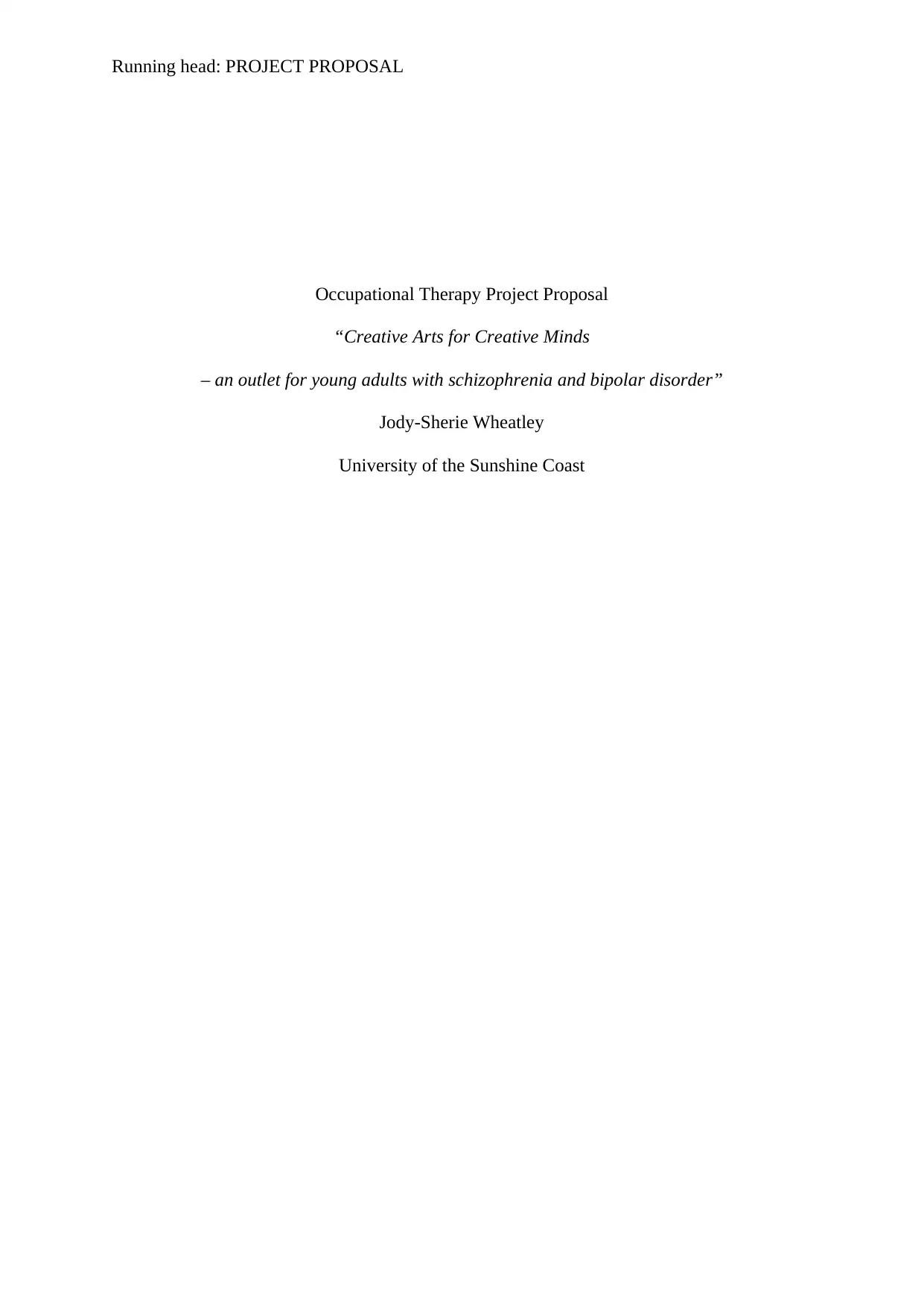
Running head: PROJECT PROPOSAL
Occupational Therapy Project Proposal
“Creative Arts for Creative Minds
– an outlet for young adults with schizophrenia and bipolar disorder”
Jody-Sherie Wheatley
University of the Sunshine Coast
Occupational Therapy Project Proposal
“Creative Arts for Creative Minds
– an outlet for young adults with schizophrenia and bipolar disorder”
Jody-Sherie Wheatley
University of the Sunshine Coast
Paraphrase This Document
Need a fresh take? Get an instant paraphrase of this document with our AI Paraphraser

PROJECT PROPOSAL
Table of contents
1. Introduction.......................................................................................................3
2. Background and significance.............................................................................3
3. Literature review................................................................................................4
4. Literature on societal issues and implications
associated with schizophrenia and mental disorder..............................................5
-Psychological issues
-Identification of the needs of the clients
-Ongoing occupational program in Australia
5. Methodology......................................................................................................7
-Community based occupational program plan
-Service delivery models
-Finding the occupational profile
6. Procedure.........................................................................................................8
-Principles of group behaviour change
-Bandura’s self efficacy
7. Occupations for clients with mental illness disorder......................................9
8. Occupational theory models .........................................................................11
-Model of human occupation
-Occupational performance model
-Person-environment occupation model
-Kawa model
9. Client-centered approach to occupational interventions ................................13
10. Outcome of occupational program................................................................13
11. Conclusion.....................................................................................................14
12. References.....................................................................................................15
2
Table of contents
1. Introduction.......................................................................................................3
2. Background and significance.............................................................................3
3. Literature review................................................................................................4
4. Literature on societal issues and implications
associated with schizophrenia and mental disorder..............................................5
-Psychological issues
-Identification of the needs of the clients
-Ongoing occupational program in Australia
5. Methodology......................................................................................................7
-Community based occupational program plan
-Service delivery models
-Finding the occupational profile
6. Procedure.........................................................................................................8
-Principles of group behaviour change
-Bandura’s self efficacy
7. Occupations for clients with mental illness disorder......................................9
8. Occupational theory models .........................................................................11
-Model of human occupation
-Occupational performance model
-Person-environment occupation model
-Kawa model
9. Client-centered approach to occupational interventions ................................13
10. Outcome of occupational program................................................................13
11. Conclusion.....................................................................................................14
12. References.....................................................................................................15
2
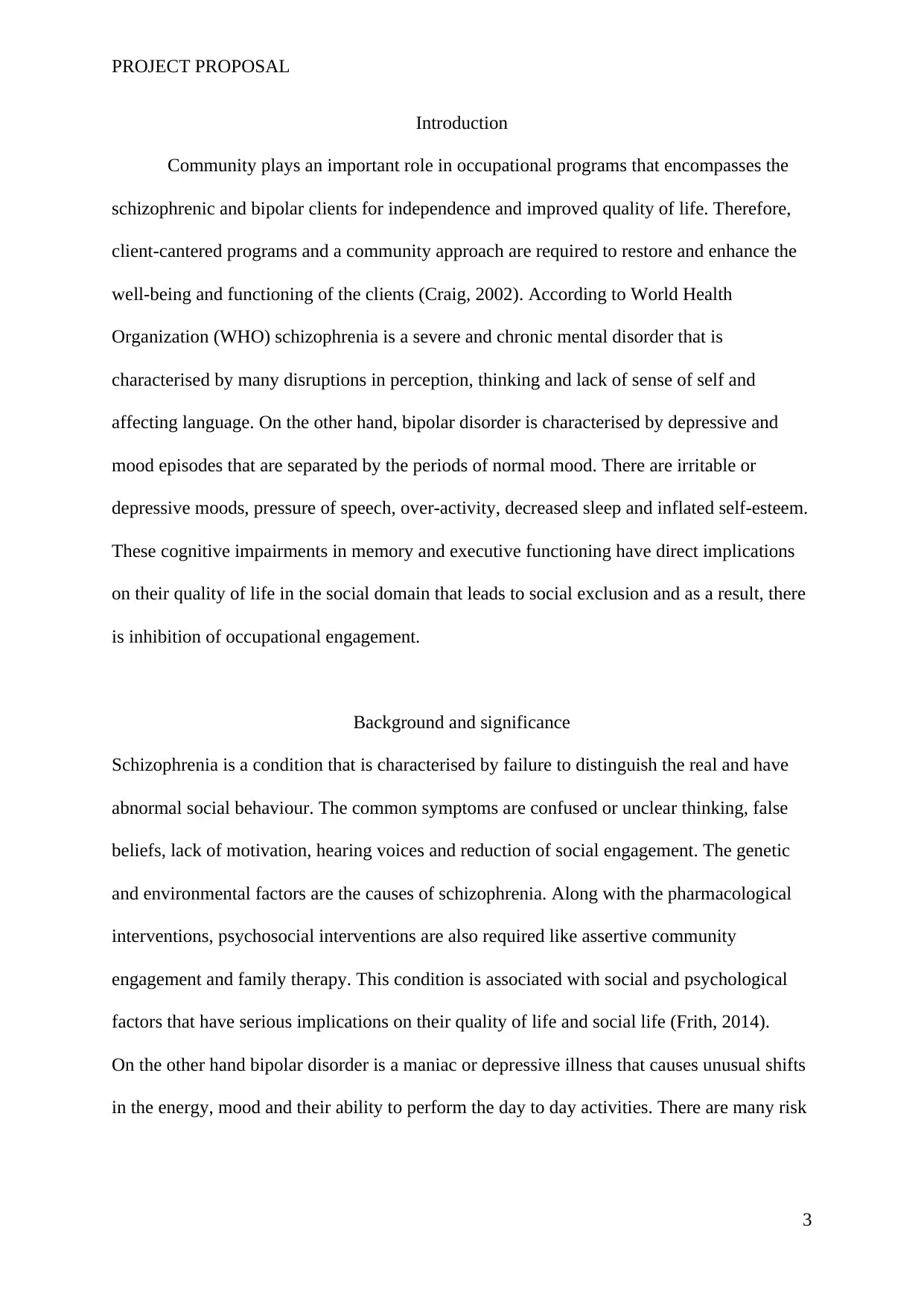
PROJECT PROPOSAL
Introduction
Community plays an important role in occupational programs that encompasses the
schizophrenic and bipolar clients for independence and improved quality of life. Therefore,
client-cantered programs and a community approach are required to restore and enhance the
well-being and functioning of the clients (Craig, 2002). According to World Health
Organization (WHO) schizophrenia is a severe and chronic mental disorder that is
characterised by many disruptions in perception, thinking and lack of sense of self and
affecting language. On the other hand, bipolar disorder is characterised by depressive and
mood episodes that are separated by the periods of normal mood. There are irritable or
depressive moods, pressure of speech, over-activity, decreased sleep and inflated self-esteem.
These cognitive impairments in memory and executive functioning have direct implications
on their quality of life in the social domain that leads to social exclusion and as a result, there
is inhibition of occupational engagement.
Background and significance
Schizophrenia is a condition that is characterised by failure to distinguish the real and have
abnormal social behaviour. The common symptoms are confused or unclear thinking, false
beliefs, lack of motivation, hearing voices and reduction of social engagement. The genetic
and environmental factors are the causes of schizophrenia. Along with the pharmacological
interventions, psychosocial interventions are also required like assertive community
engagement and family therapy. This condition is associated with social and psychological
factors that have serious implications on their quality of life and social life (Frith, 2014).
On the other hand bipolar disorder is a maniac or depressive illness that causes unusual shifts
in the energy, mood and their ability to perform the day to day activities. There are many risk
3
Introduction
Community plays an important role in occupational programs that encompasses the
schizophrenic and bipolar clients for independence and improved quality of life. Therefore,
client-cantered programs and a community approach are required to restore and enhance the
well-being and functioning of the clients (Craig, 2002). According to World Health
Organization (WHO) schizophrenia is a severe and chronic mental disorder that is
characterised by many disruptions in perception, thinking and lack of sense of self and
affecting language. On the other hand, bipolar disorder is characterised by depressive and
mood episodes that are separated by the periods of normal mood. There are irritable or
depressive moods, pressure of speech, over-activity, decreased sleep and inflated self-esteem.
These cognitive impairments in memory and executive functioning have direct implications
on their quality of life in the social domain that leads to social exclusion and as a result, there
is inhibition of occupational engagement.
Background and significance
Schizophrenia is a condition that is characterised by failure to distinguish the real and have
abnormal social behaviour. The common symptoms are confused or unclear thinking, false
beliefs, lack of motivation, hearing voices and reduction of social engagement. The genetic
and environmental factors are the causes of schizophrenia. Along with the pharmacological
interventions, psychosocial interventions are also required like assertive community
engagement and family therapy. This condition is associated with social and psychological
factors that have serious implications on their quality of life and social life (Frith, 2014).
On the other hand bipolar disorder is a maniac or depressive illness that causes unusual shifts
in the energy, mood and their ability to perform the day to day activities. There are many risk
3
⊘ This is a preview!⊘
Do you want full access?
Subscribe today to unlock all pages.

Trusted by 1+ million students worldwide
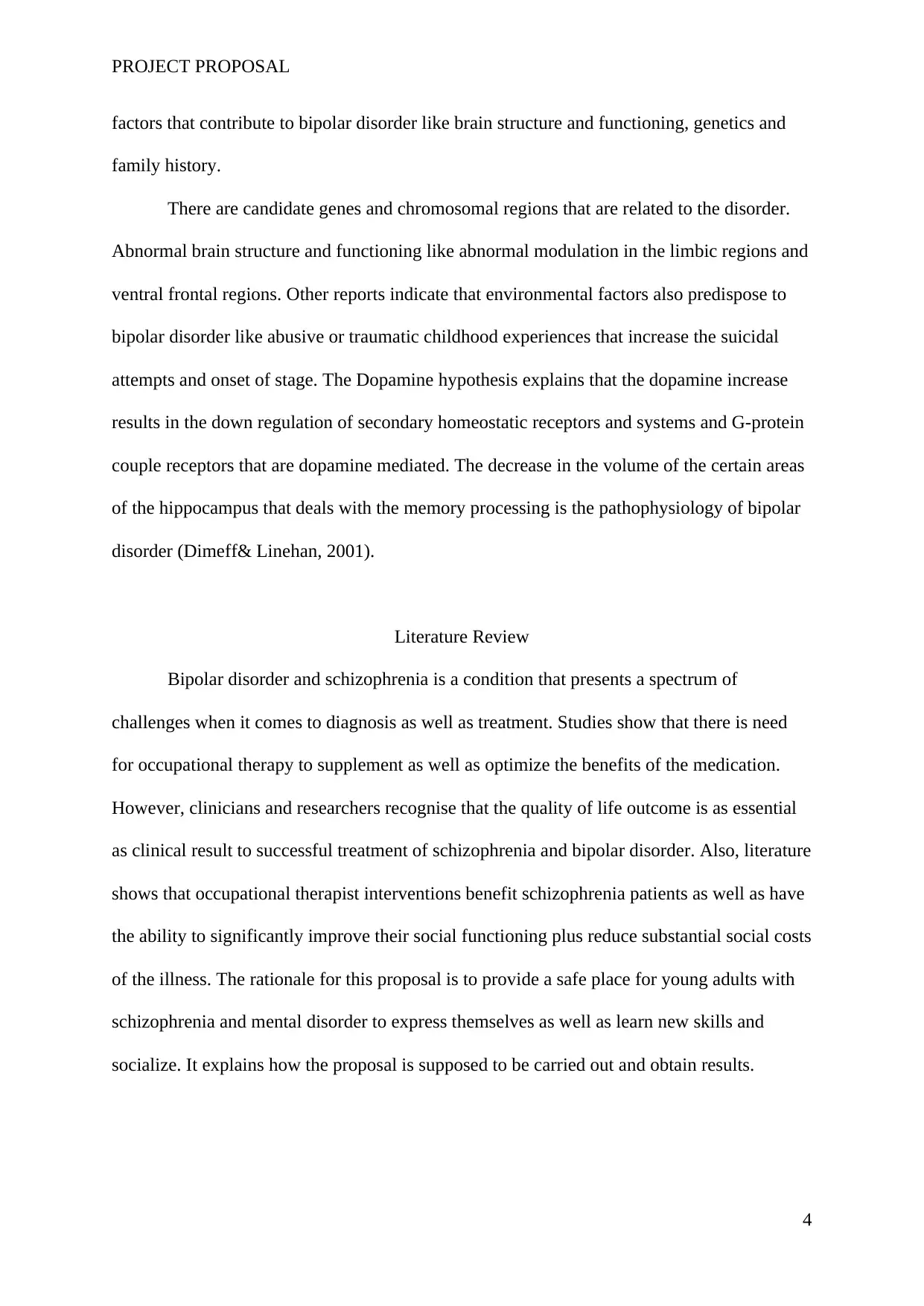
PROJECT PROPOSAL
factors that contribute to bipolar disorder like brain structure and functioning, genetics and
family history.
There are candidate genes and chromosomal regions that are related to the disorder.
Abnormal brain structure and functioning like abnormal modulation in the limbic regions and
ventral frontal regions. Other reports indicate that environmental factors also predispose to
bipolar disorder like abusive or traumatic childhood experiences that increase the suicidal
attempts and onset of stage. The Dopamine hypothesis explains that the dopamine increase
results in the down regulation of secondary homeostatic receptors and systems and G-protein
couple receptors that are dopamine mediated. The decrease in the volume of the certain areas
of the hippocampus that deals with the memory processing is the pathophysiology of bipolar
disorder (Dimeff& Linehan, 2001).
Literature Review
Bipolar disorder and schizophrenia is a condition that presents a spectrum of
challenges when it comes to diagnosis as well as treatment. Studies show that there is need
for occupational therapy to supplement as well as optimize the benefits of the medication.
However, clinicians and researchers recognise that the quality of life outcome is as essential
as clinical result to successful treatment of schizophrenia and bipolar disorder. Also, literature
shows that occupational therapist interventions benefit schizophrenia patients as well as have
the ability to significantly improve their social functioning plus reduce substantial social costs
of the illness. The rationale for this proposal is to provide a safe place for young adults with
schizophrenia and mental disorder to express themselves as well as learn new skills and
socialize. It explains how the proposal is supposed to be carried out and obtain results.
4
factors that contribute to bipolar disorder like brain structure and functioning, genetics and
family history.
There are candidate genes and chromosomal regions that are related to the disorder.
Abnormal brain structure and functioning like abnormal modulation in the limbic regions and
ventral frontal regions. Other reports indicate that environmental factors also predispose to
bipolar disorder like abusive or traumatic childhood experiences that increase the suicidal
attempts and onset of stage. The Dopamine hypothesis explains that the dopamine increase
results in the down regulation of secondary homeostatic receptors and systems and G-protein
couple receptors that are dopamine mediated. The decrease in the volume of the certain areas
of the hippocampus that deals with the memory processing is the pathophysiology of bipolar
disorder (Dimeff& Linehan, 2001).
Literature Review
Bipolar disorder and schizophrenia is a condition that presents a spectrum of
challenges when it comes to diagnosis as well as treatment. Studies show that there is need
for occupational therapy to supplement as well as optimize the benefits of the medication.
However, clinicians and researchers recognise that the quality of life outcome is as essential
as clinical result to successful treatment of schizophrenia and bipolar disorder. Also, literature
shows that occupational therapist interventions benefit schizophrenia patients as well as have
the ability to significantly improve their social functioning plus reduce substantial social costs
of the illness. The rationale for this proposal is to provide a safe place for young adults with
schizophrenia and mental disorder to express themselves as well as learn new skills and
socialize. It explains how the proposal is supposed to be carried out and obtain results.
4
Paraphrase This Document
Need a fresh take? Get an instant paraphrase of this document with our AI Paraphraser
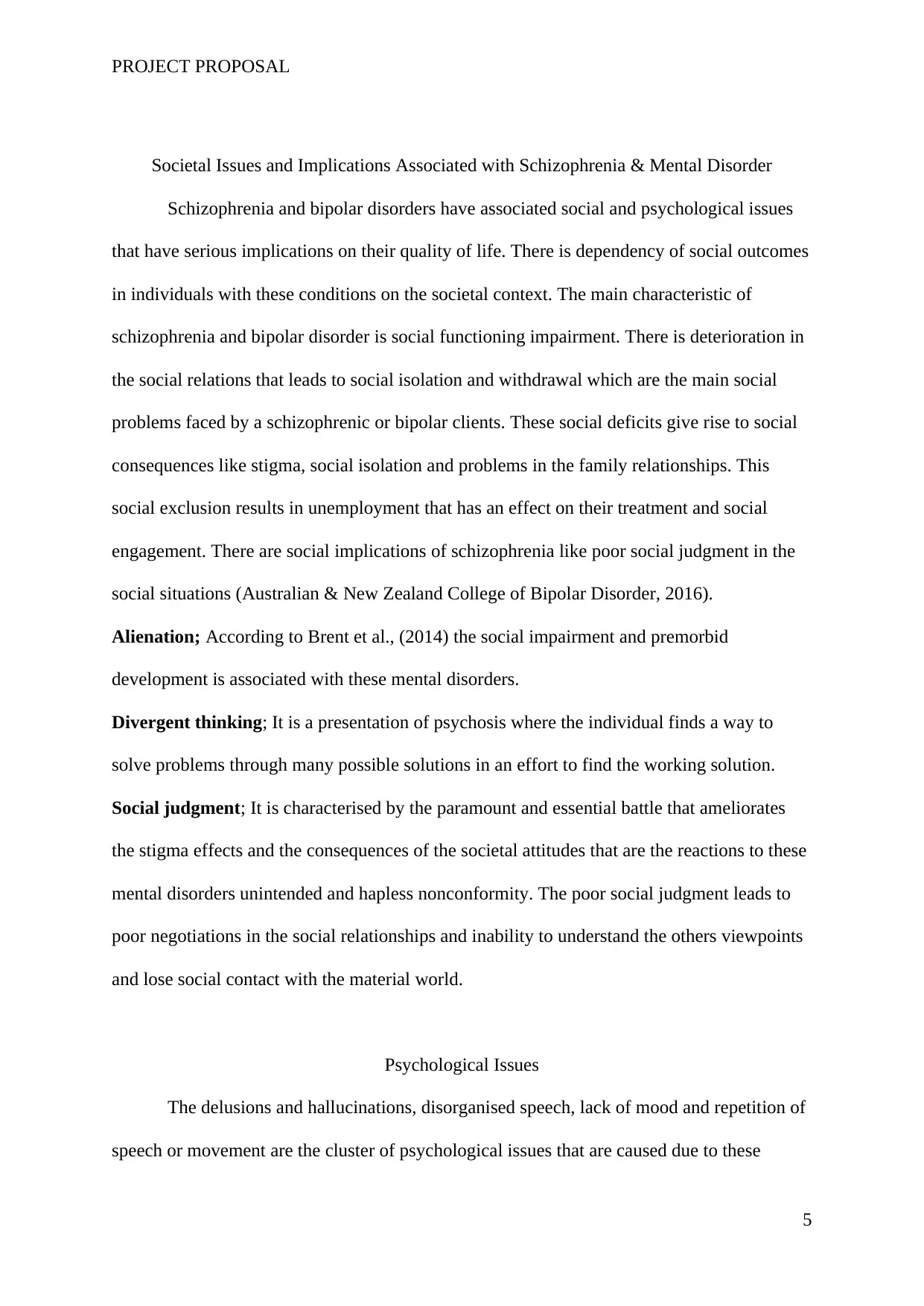
PROJECT PROPOSAL
Societal Issues and Implications Associated with Schizophrenia & Mental Disorder
Schizophrenia and bipolar disorders have associated social and psychological issues
that have serious implications on their quality of life. There is dependency of social outcomes
in individuals with these conditions on the societal context. The main characteristic of
schizophrenia and bipolar disorder is social functioning impairment. There is deterioration in
the social relations that leads to social isolation and withdrawal which are the main social
problems faced by a schizophrenic or bipolar clients. These social deficits give rise to social
consequences like stigma, social isolation and problems in the family relationships. This
social exclusion results in unemployment that has an effect on their treatment and social
engagement. There are social implications of schizophrenia like poor social judgment in the
social situations (Australian & New Zealand College of Bipolar Disorder, 2016).
Alienation; According to Brent et al., (2014) the social impairment and premorbid
development is associated with these mental disorders.
Divergent thinking; It is a presentation of psychosis where the individual finds a way to
solve problems through many possible solutions in an effort to find the working solution.
Social judgment; It is characterised by the paramount and essential battle that ameliorates
the stigma effects and the consequences of the societal attitudes that are the reactions to these
mental disorders unintended and hapless nonconformity. The poor social judgment leads to
poor negotiations in the social relationships and inability to understand the others viewpoints
and lose social contact with the material world.
Psychological Issues
The delusions and hallucinations, disorganised speech, lack of mood and repetition of
speech or movement are the cluster of psychological issues that are caused due to these
5
Societal Issues and Implications Associated with Schizophrenia & Mental Disorder
Schizophrenia and bipolar disorders have associated social and psychological issues
that have serious implications on their quality of life. There is dependency of social outcomes
in individuals with these conditions on the societal context. The main characteristic of
schizophrenia and bipolar disorder is social functioning impairment. There is deterioration in
the social relations that leads to social isolation and withdrawal which are the main social
problems faced by a schizophrenic or bipolar clients. These social deficits give rise to social
consequences like stigma, social isolation and problems in the family relationships. This
social exclusion results in unemployment that has an effect on their treatment and social
engagement. There are social implications of schizophrenia like poor social judgment in the
social situations (Australian & New Zealand College of Bipolar Disorder, 2016).
Alienation; According to Brent et al., (2014) the social impairment and premorbid
development is associated with these mental disorders.
Divergent thinking; It is a presentation of psychosis where the individual finds a way to
solve problems through many possible solutions in an effort to find the working solution.
Social judgment; It is characterised by the paramount and essential battle that ameliorates
the stigma effects and the consequences of the societal attitudes that are the reactions to these
mental disorders unintended and hapless nonconformity. The poor social judgment leads to
poor negotiations in the social relationships and inability to understand the others viewpoints
and lose social contact with the material world.
Psychological Issues
The delusions and hallucinations, disorganised speech, lack of mood and repetition of
speech or movement are the cluster of psychological issues that are caused due to these
5

PROJECT PROPOSAL
mental disorders. However, gradual progression of these symptoms severely affects the social
life and they try to withdraw themselves from the social life due to exhibition of
inappropriate mood that makes the social relationships difficult. These consequences lead to
joblessness and there is social disengagement and in community participation. Therefore,
there is a need for community participation and programming that is lacking in the system to
help these individuals living with the disorder (Niv et al., 2014).
Identification of Needs for the Clients
There are unmet needs of these individuals and need for community based programs
that are devoted to the economic and psychosocial needs where they face economic
difficulties and lack of community care. Some of the unmet psychosocial needs find their
way to the reinforcement of these individuals and in improving their quality of life. Many
people are not familiar with these mental health disorders and consider them to be subjects of
violence and different from the general population. There is discrimination and stigma that
restricts these individuals in availing the healthcare services and options for employment.
Therefore, there are many community-based occupational programs and public health
initiatives that are being implemented in many regions of the country to include these
individuals into the mainstream (Pitschel-Walz et al., 2015).There is less acceptance and lack
of awareness and understanding of the prevailing mental disorders in the community.
Ongoing Occupational Program in Australia
The Occupational Therapy Practice Framework (OTPF) was developed with an aim to
define and guide occupational therapists. There is reference to specific models that articulate
occupational programs to improve the quality of life for people living with these mental
disorders (Mulligan et al., 2014). For example, Mind, Australia is one of the country’s
6
mental disorders. However, gradual progression of these symptoms severely affects the social
life and they try to withdraw themselves from the social life due to exhibition of
inappropriate mood that makes the social relationships difficult. These consequences lead to
joblessness and there is social disengagement and in community participation. Therefore,
there is a need for community participation and programming that is lacking in the system to
help these individuals living with the disorder (Niv et al., 2014).
Identification of Needs for the Clients
There are unmet needs of these individuals and need for community based programs
that are devoted to the economic and psychosocial needs where they face economic
difficulties and lack of community care. Some of the unmet psychosocial needs find their
way to the reinforcement of these individuals and in improving their quality of life. Many
people are not familiar with these mental health disorders and consider them to be subjects of
violence and different from the general population. There is discrimination and stigma that
restricts these individuals in availing the healthcare services and options for employment.
Therefore, there are many community-based occupational programs and public health
initiatives that are being implemented in many regions of the country to include these
individuals into the mainstream (Pitschel-Walz et al., 2015).There is less acceptance and lack
of awareness and understanding of the prevailing mental disorders in the community.
Ongoing Occupational Program in Australia
The Occupational Therapy Practice Framework (OTPF) was developed with an aim to
define and guide occupational therapists. There is reference to specific models that articulate
occupational programs to improve the quality of life for people living with these mental
disorders (Mulligan et al., 2014). For example, Mind, Australia is one of the country’s
6
⊘ This is a preview!⊘
Do you want full access?
Subscribe today to unlock all pages.

Trusted by 1+ million students worldwide

PROJECT PROPOSAL
leading community-based mental health services that support people who are dealing with
daily struggles due to the mental illness implications over 40 years. They provide healthcare
services and motivational support to these individuals and offer social connection through
group activities (Brady et al., 2017).
Methodology
1. Community-Based Occupational Program Plan
For the development of a community-based occupational plan, the occupational
therapists play an important role in selecting activities and occupations that would help to
achieve the desired needs of client (Hagedorn, 2000). Firstly, there is interaction between the
occupational therapists with the clients to take note of their environmental and social context
and decide on occupations that are suited to the client. A program desired to meet a variety of
interests to accommodate many clients. Creative Arts for Creative Minds is a performing arts
group exclusive to clients with a mental disorder. This step requires understanding of the
dynamic and complex client factors, performance patterns, skills and activity demands. The
plan would also decide on the aspects that influence the clients and evaluate the performances
of the clients that would support their occupational performance.
2. Service Delivery Models
The service delivery model would help provide direct services to the clients in a
community setting. For this, direct contact with the clients is important through meetings,
group session and through telehealth systems (Young, Klosko&Weishaar, 2003). Providing a
service called Creative Arts for Creative Minds would provide clients with the opportunity to
socialise with others diagnosed with a mental illness and schizophrenia. It is a space to
express oneself through drama and role playing. There is also opportunity for parents/carers
7
leading community-based mental health services that support people who are dealing with
daily struggles due to the mental illness implications over 40 years. They provide healthcare
services and motivational support to these individuals and offer social connection through
group activities (Brady et al., 2017).
Methodology
1. Community-Based Occupational Program Plan
For the development of a community-based occupational plan, the occupational
therapists play an important role in selecting activities and occupations that would help to
achieve the desired needs of client (Hagedorn, 2000). Firstly, there is interaction between the
occupational therapists with the clients to take note of their environmental and social context
and decide on occupations that are suited to the client. A program desired to meet a variety of
interests to accommodate many clients. Creative Arts for Creative Minds is a performing arts
group exclusive to clients with a mental disorder. This step requires understanding of the
dynamic and complex client factors, performance patterns, skills and activity demands. The
plan would also decide on the aspects that influence the clients and evaluate the performances
of the clients that would support their occupational performance.
2. Service Delivery Models
The service delivery model would help provide direct services to the clients in a
community setting. For this, direct contact with the clients is important through meetings,
group session and through telehealth systems (Young, Klosko&Weishaar, 2003). Providing a
service called Creative Arts for Creative Minds would provide clients with the opportunity to
socialise with others diagnosed with a mental illness and schizophrenia. It is a space to
express oneself through drama and role playing. There is also opportunity for parents/carers
7
Paraphrase This Document
Need a fresh take? Get an instant paraphrase of this document with our AI Paraphraser
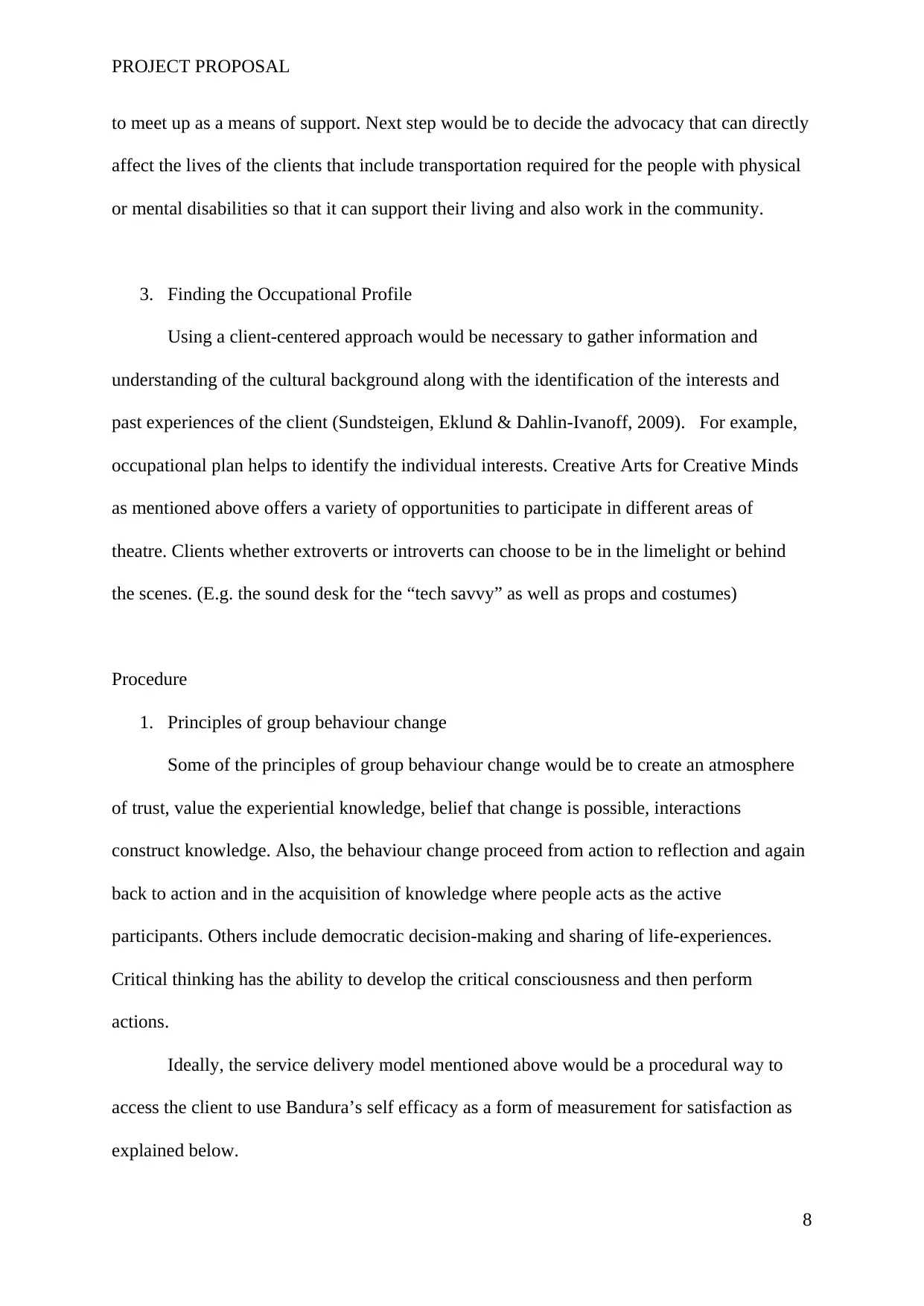
PROJECT PROPOSAL
to meet up as a means of support. Next step would be to decide the advocacy that can directly
affect the lives of the clients that include transportation required for the people with physical
or mental disabilities so that it can support their living and also work in the community.
3. Finding the Occupational Profile
Using a client-centered approach would be necessary to gather information and
understanding of the cultural background along with the identification of the interests and
past experiences of the client (Sundsteigen, Eklund & Dahlin-Ivanoff, 2009). For example,
occupational plan helps to identify the individual interests. Creative Arts for Creative Minds
as mentioned above offers a variety of opportunities to participate in different areas of
theatre. Clients whether extroverts or introverts can choose to be in the limelight or behind
the scenes. (E.g. the sound desk for the “tech savvy” as well as props and costumes)
Procedure
1. Principles of group behaviour change
Some of the principles of group behaviour change would be to create an atmosphere
of trust, value the experiential knowledge, belief that change is possible, interactions
construct knowledge. Also, the behaviour change proceed from action to reflection and again
back to action and in the acquisition of knowledge where people acts as the active
participants. Others include democratic decision-making and sharing of life-experiences.
Critical thinking has the ability to develop the critical consciousness and then perform
actions.
Ideally, the service delivery model mentioned above would be a procedural way to
access the client to use Bandura’s self efficacy as a form of measurement for satisfaction as
explained below.
8
to meet up as a means of support. Next step would be to decide the advocacy that can directly
affect the lives of the clients that include transportation required for the people with physical
or mental disabilities so that it can support their living and also work in the community.
3. Finding the Occupational Profile
Using a client-centered approach would be necessary to gather information and
understanding of the cultural background along with the identification of the interests and
past experiences of the client (Sundsteigen, Eklund & Dahlin-Ivanoff, 2009). For example,
occupational plan helps to identify the individual interests. Creative Arts for Creative Minds
as mentioned above offers a variety of opportunities to participate in different areas of
theatre. Clients whether extroverts or introverts can choose to be in the limelight or behind
the scenes. (E.g. the sound desk for the “tech savvy” as well as props and costumes)
Procedure
1. Principles of group behaviour change
Some of the principles of group behaviour change would be to create an atmosphere
of trust, value the experiential knowledge, belief that change is possible, interactions
construct knowledge. Also, the behaviour change proceed from action to reflection and again
back to action and in the acquisition of knowledge where people acts as the active
participants. Others include democratic decision-making and sharing of life-experiences.
Critical thinking has the ability to develop the critical consciousness and then perform
actions.
Ideally, the service delivery model mentioned above would be a procedural way to
access the client to use Bandura’s self efficacy as a form of measurement for satisfaction as
explained below.
8
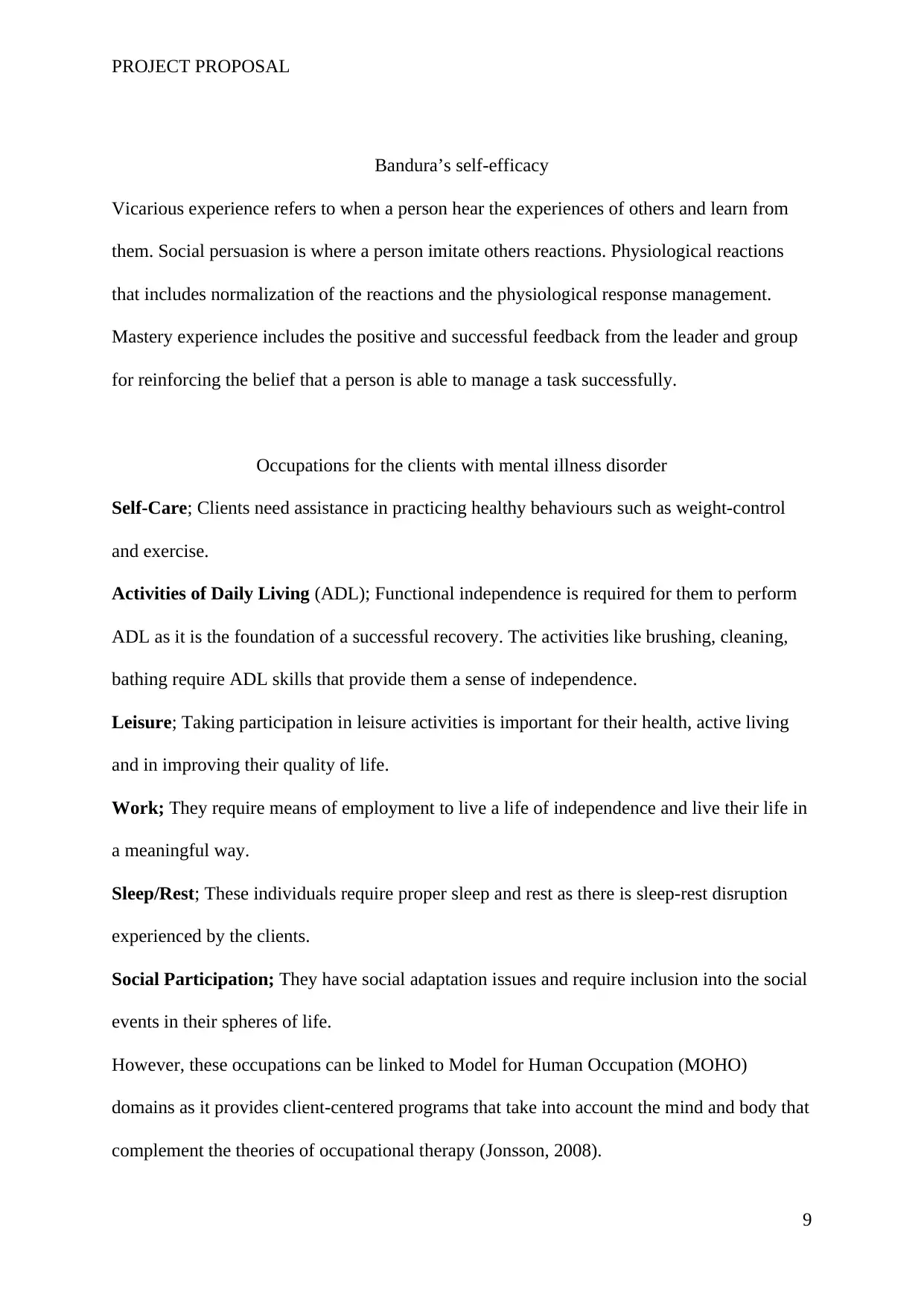
PROJECT PROPOSAL
Bandura’s self-efficacy
Vicarious experience refers to when a person hear the experiences of others and learn from
them. Social persuasion is where a person imitate others reactions. Physiological reactions
that includes normalization of the reactions and the physiological response management.
Mastery experience includes the positive and successful feedback from the leader and group
for reinforcing the belief that a person is able to manage a task successfully.
Occupations for the clients with mental illness disorder
Self-Care; Clients need assistance in practicing healthy behaviours such as weight-control
and exercise.
Activities of Daily Living (ADL); Functional independence is required for them to perform
ADL as it is the foundation of a successful recovery. The activities like brushing, cleaning,
bathing require ADL skills that provide them a sense of independence.
Leisure; Taking participation in leisure activities is important for their health, active living
and in improving their quality of life.
Work; They require means of employment to live a life of independence and live their life in
a meaningful way.
Sleep/Rest; These individuals require proper sleep and rest as there is sleep-rest disruption
experienced by the clients.
Social Participation; They have social adaptation issues and require inclusion into the social
events in their spheres of life.
However, these occupations can be linked to Model for Human Occupation (MOHO)
domains as it provides client-centered programs that take into account the mind and body that
complement the theories of occupational therapy (Jonsson, 2008).
9
Bandura’s self-efficacy
Vicarious experience refers to when a person hear the experiences of others and learn from
them. Social persuasion is where a person imitate others reactions. Physiological reactions
that includes normalization of the reactions and the physiological response management.
Mastery experience includes the positive and successful feedback from the leader and group
for reinforcing the belief that a person is able to manage a task successfully.
Occupations for the clients with mental illness disorder
Self-Care; Clients need assistance in practicing healthy behaviours such as weight-control
and exercise.
Activities of Daily Living (ADL); Functional independence is required for them to perform
ADL as it is the foundation of a successful recovery. The activities like brushing, cleaning,
bathing require ADL skills that provide them a sense of independence.
Leisure; Taking participation in leisure activities is important for their health, active living
and in improving their quality of life.
Work; They require means of employment to live a life of independence and live their life in
a meaningful way.
Sleep/Rest; These individuals require proper sleep and rest as there is sleep-rest disruption
experienced by the clients.
Social Participation; They have social adaptation issues and require inclusion into the social
events in their spheres of life.
However, these occupations can be linked to Model for Human Occupation (MOHO)
domains as it provides client-centered programs that take into account the mind and body that
complement the theories of occupational therapy (Jonsson, 2008).
9
⊘ This is a preview!⊘
Do you want full access?
Subscribe today to unlock all pages.

Trusted by 1+ million students worldwide
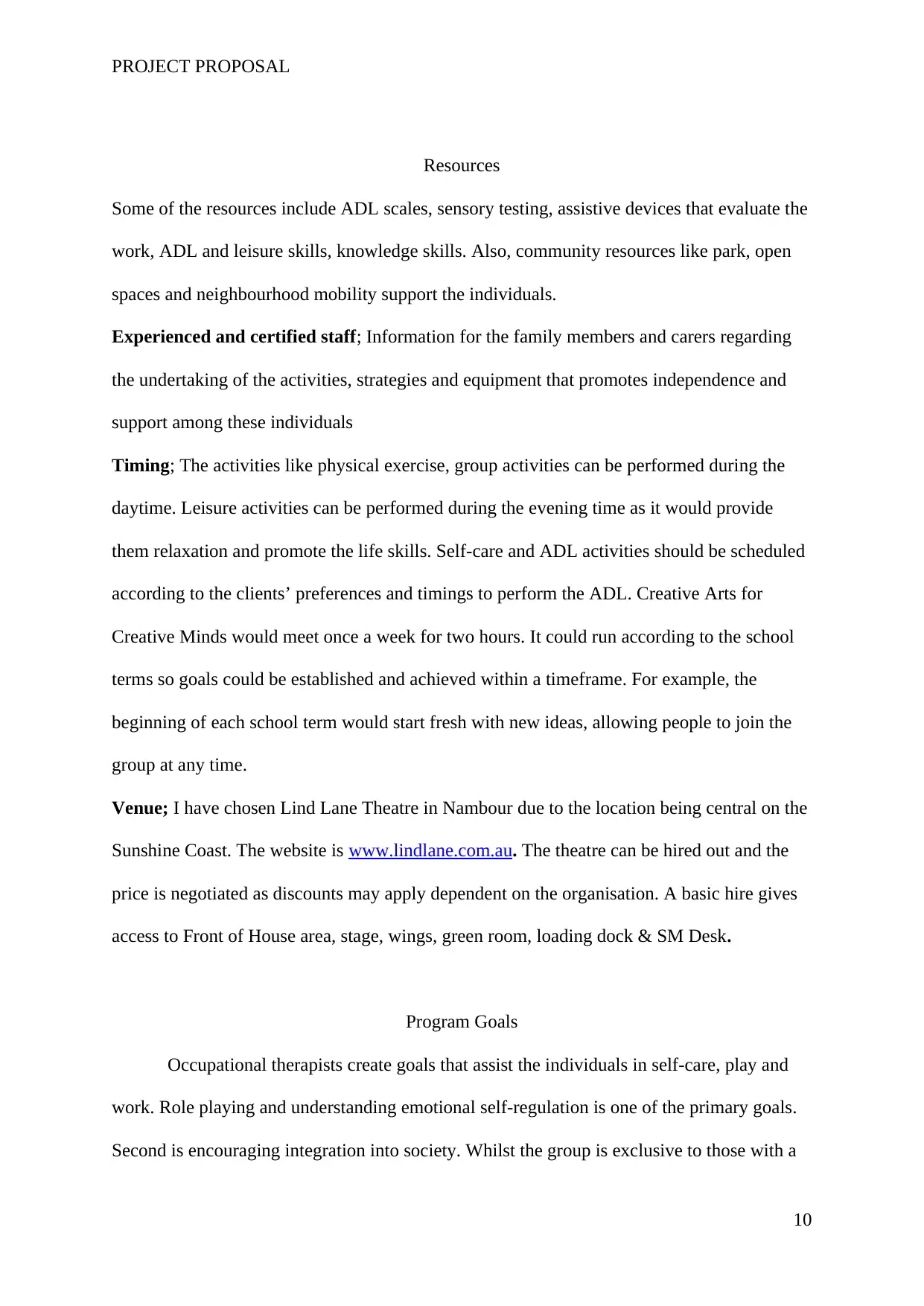
PROJECT PROPOSAL
Resources
Some of the resources include ADL scales, sensory testing, assistive devices that evaluate the
work, ADL and leisure skills, knowledge skills. Also, community resources like park, open
spaces and neighbourhood mobility support the individuals.
Experienced and certified staff; Information for the family members and carers regarding
the undertaking of the activities, strategies and equipment that promotes independence and
support among these individuals
Timing; The activities like physical exercise, group activities can be performed during the
daytime. Leisure activities can be performed during the evening time as it would provide
them relaxation and promote the life skills. Self-care and ADL activities should be scheduled
according to the clients’ preferences and timings to perform the ADL. Creative Arts for
Creative Minds would meet once a week for two hours. It could run according to the school
terms so goals could be established and achieved within a timeframe. For example, the
beginning of each school term would start fresh with new ideas, allowing people to join the
group at any time.
Venue; I have chosen Lind Lane Theatre in Nambour due to the location being central on the
Sunshine Coast. The website is www.lindlane.com.au. The theatre can be hired out and the
price is negotiated as discounts may apply dependent on the organisation. A basic hire gives
access to Front of House area, stage, wings, green room, loading dock & SM Desk.
Program Goals
Occupational therapists create goals that assist the individuals in self-care, play and
work. Role playing and understanding emotional self-regulation is one of the primary goals.
Second is encouraging integration into society. Whilst the group is exclusive to those with a
10
Resources
Some of the resources include ADL scales, sensory testing, assistive devices that evaluate the
work, ADL and leisure skills, knowledge skills. Also, community resources like park, open
spaces and neighbourhood mobility support the individuals.
Experienced and certified staff; Information for the family members and carers regarding
the undertaking of the activities, strategies and equipment that promotes independence and
support among these individuals
Timing; The activities like physical exercise, group activities can be performed during the
daytime. Leisure activities can be performed during the evening time as it would provide
them relaxation and promote the life skills. Self-care and ADL activities should be scheduled
according to the clients’ preferences and timings to perform the ADL. Creative Arts for
Creative Minds would meet once a week for two hours. It could run according to the school
terms so goals could be established and achieved within a timeframe. For example, the
beginning of each school term would start fresh with new ideas, allowing people to join the
group at any time.
Venue; I have chosen Lind Lane Theatre in Nambour due to the location being central on the
Sunshine Coast. The website is www.lindlane.com.au. The theatre can be hired out and the
price is negotiated as discounts may apply dependent on the organisation. A basic hire gives
access to Front of House area, stage, wings, green room, loading dock & SM Desk.
Program Goals
Occupational therapists create goals that assist the individuals in self-care, play and
work. Role playing and understanding emotional self-regulation is one of the primary goals.
Second is encouraging integration into society. Whilst the group is exclusive to those with a
10
Paraphrase This Document
Need a fresh take? Get an instant paraphrase of this document with our AI Paraphraser

PROJECT PROPOSAL
mental illness diagnoses, there is opportunity to participate in mainstream theatre. There are a
number of performing art groups on the coast that hold auditions if the clients are confident.
Third is to assist clients in learning to perform new tasks according to their desires (Shimada
et al., 2016). Depending on client interest, there are several areas in theatre where one could
learn new skills and develop confidence and possibly lead to work opportunities. Being able
to work in a group, share ideas and thoughts is another program goal where the occupational
therapist should accept constructive criticism and be able to change or adapt.
Short term goals; These are designed to help the clients enjoy success and work towards
goals to be achieved in few weeks or months.
Long-term goals; They are performed when the clients are able to finally reach the ultimate
goals where they would be able to live life independently and learn to live with the disability.
Program Activities; These activities are designed according to the capability and preferences
of the clients. They include writing Storylines/plays/poems, acting/role playing, creating
props/art & craft, sound & lighting desk/computers and making costumes/sewing
Participant Recruitment; The recruitment of the participants is a challenging task.
However, referrals would be the most effective way to gather clients together, either through
GP’s or psychologists or psychiatrists.
Occupational Theory Models
Model of Human Occupation (MOHO)
It involves human occupation that is being influenced by volition, habituation and
performance aspects and the environment. It motivates the person’s values, interests and
belief in the skill. Habituation helps a person to understand their role in their lives, pattern of
behaviour, routine and rules in life. It provides a framework for holistic and client-centered
11
mental illness diagnoses, there is opportunity to participate in mainstream theatre. There are a
number of performing art groups on the coast that hold auditions if the clients are confident.
Third is to assist clients in learning to perform new tasks according to their desires (Shimada
et al., 2016). Depending on client interest, there are several areas in theatre where one could
learn new skills and develop confidence and possibly lead to work opportunities. Being able
to work in a group, share ideas and thoughts is another program goal where the occupational
therapist should accept constructive criticism and be able to change or adapt.
Short term goals; These are designed to help the clients enjoy success and work towards
goals to be achieved in few weeks or months.
Long-term goals; They are performed when the clients are able to finally reach the ultimate
goals where they would be able to live life independently and learn to live with the disability.
Program Activities; These activities are designed according to the capability and preferences
of the clients. They include writing Storylines/plays/poems, acting/role playing, creating
props/art & craft, sound & lighting desk/computers and making costumes/sewing
Participant Recruitment; The recruitment of the participants is a challenging task.
However, referrals would be the most effective way to gather clients together, either through
GP’s or psychologists or psychiatrists.
Occupational Theory Models
Model of Human Occupation (MOHO)
It involves human occupation that is being influenced by volition, habituation and
performance aspects and the environment. It motivates the person’s values, interests and
belief in the skill. Habituation helps a person to understand their role in their lives, pattern of
behaviour, routine and rules in life. It provides a framework for holistic and client-centered
11
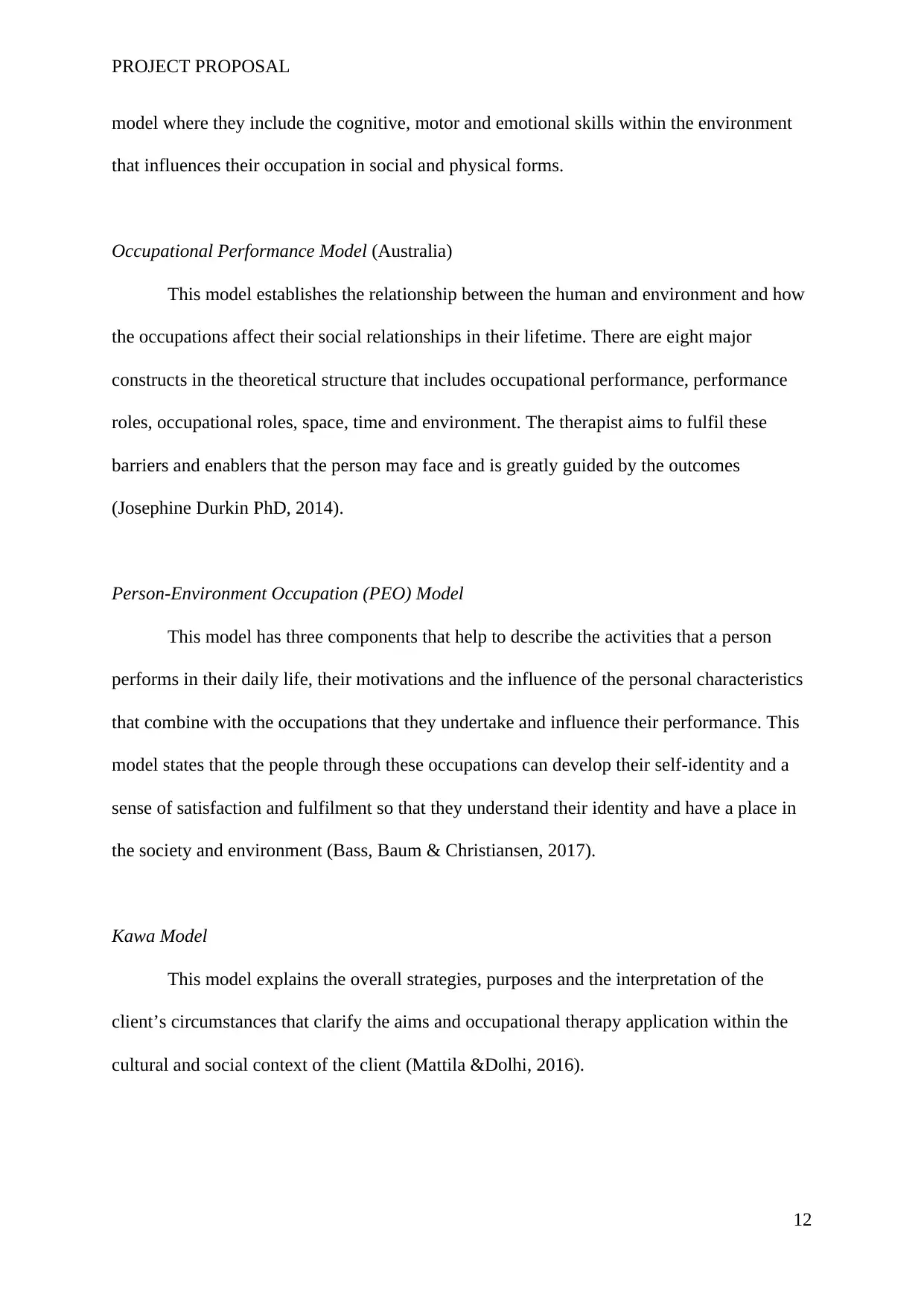
PROJECT PROPOSAL
model where they include the cognitive, motor and emotional skills within the environment
that influences their occupation in social and physical forms.
Occupational Performance Model (Australia)
This model establishes the relationship between the human and environment and how
the occupations affect their social relationships in their lifetime. There are eight major
constructs in the theoretical structure that includes occupational performance, performance
roles, occupational roles, space, time and environment. The therapist aims to fulfil these
barriers and enablers that the person may face and is greatly guided by the outcomes
(Josephine Durkin PhD, 2014).
Person-Environment Occupation (PEO) Model
This model has three components that help to describe the activities that a person
performs in their daily life, their motivations and the influence of the personal characteristics
that combine with the occupations that they undertake and influence their performance. This
model states that the people through these occupations can develop their self-identity and a
sense of satisfaction and fulfilment so that they understand their identity and have a place in
the society and environment (Bass, Baum & Christiansen, 2017).
Kawa Model
This model explains the overall strategies, purposes and the interpretation of the
client’s circumstances that clarify the aims and occupational therapy application within the
cultural and social context of the client (Mattila &Dolhi, 2016).
12
model where they include the cognitive, motor and emotional skills within the environment
that influences their occupation in social and physical forms.
Occupational Performance Model (Australia)
This model establishes the relationship between the human and environment and how
the occupations affect their social relationships in their lifetime. There are eight major
constructs in the theoretical structure that includes occupational performance, performance
roles, occupational roles, space, time and environment. The therapist aims to fulfil these
barriers and enablers that the person may face and is greatly guided by the outcomes
(Josephine Durkin PhD, 2014).
Person-Environment Occupation (PEO) Model
This model has three components that help to describe the activities that a person
performs in their daily life, their motivations and the influence of the personal characteristics
that combine with the occupations that they undertake and influence their performance. This
model states that the people through these occupations can develop their self-identity and a
sense of satisfaction and fulfilment so that they understand their identity and have a place in
the society and environment (Bass, Baum & Christiansen, 2017).
Kawa Model
This model explains the overall strategies, purposes and the interpretation of the
client’s circumstances that clarify the aims and occupational therapy application within the
cultural and social context of the client (Mattila &Dolhi, 2016).
12
⊘ This is a preview!⊘
Do you want full access?
Subscribe today to unlock all pages.

Trusted by 1+ million students worldwide
1 out of 18
Related Documents
Your All-in-One AI-Powered Toolkit for Academic Success.
+13062052269
info@desklib.com
Available 24*7 on WhatsApp / Email
![[object Object]](/_next/static/media/star-bottom.7253800d.svg)
Unlock your academic potential
Copyright © 2020–2025 A2Z Services. All Rights Reserved. Developed and managed by ZUCOL.





